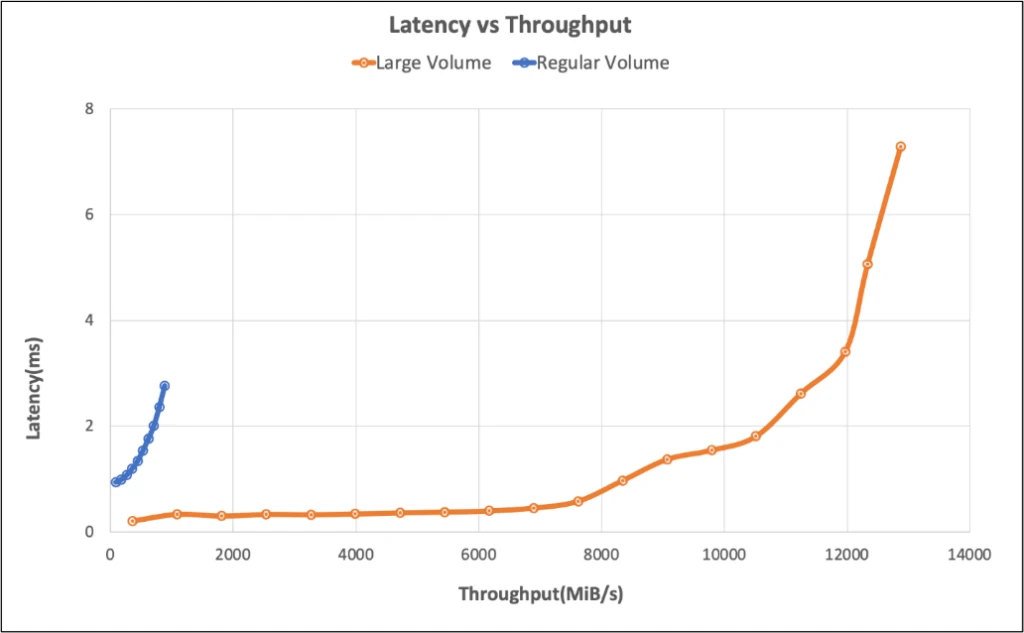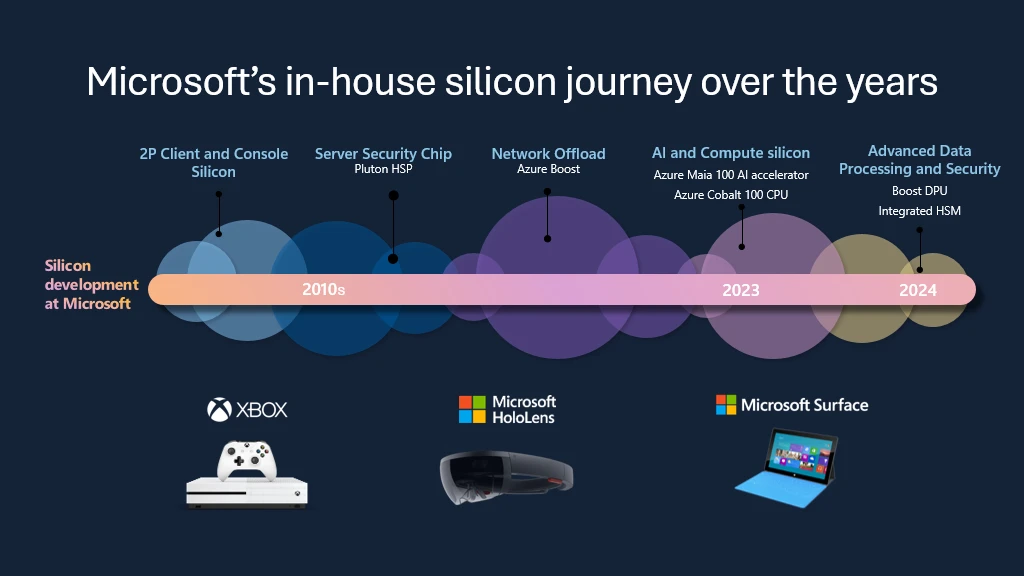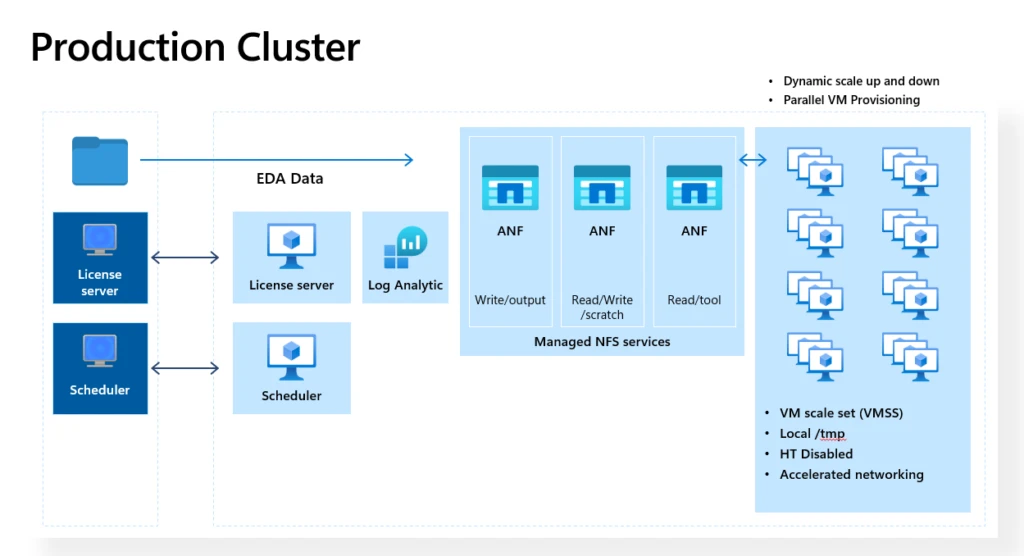Find out how the Azure {Hardware} Methods and Interconnect workforce leverages Azure NetApp Recordsdata for chip growth.
Excessive-performance computing (HPC) workloads place vital calls for on cloud infrastructure, requiring strong and scalable assets to deal with complicated and intensive computational duties. These workloads usually necessitate excessive ranges of parallel processing energy, usually supplied by clusters of central processing unit (CPU) or graphics processing unit (GPU)-based digital machines. Moreover, HPC purposes demand substantial knowledge storage and quick entry speeds, which exceed the capabilities of conventional cloud file techniques. Specialised storage options are required to fulfill the low latency and excessive throughput enter/output (I/O) wants.
Microsoft Azure NetApp Recordsdata is designed to ship low latency, excessive efficiency, and enterprise-grade knowledge administration at scale. Distinctive capabilities of Azure NetApp Recordsdata make it appropriate for a number of high-performance computing workloads resembling Digital Design Automation (EDA), Seismic Processing, Reservoir Simulations, and Threat Modeling. This weblog highlights Azure NetApp Recordsdata’ differentiated capabilities for EDA workloads and Microsoft’s silicon design journey.
Infrastructure necessities of EDA workloads
EDA workloads have intensive computational and knowledge processing necessities to handle complicated duties in simulation, bodily design, and verification. Every design stage includes a number of simulations to reinforce accuracy, enhance reliability, and detect design defects early, decreasing debugging and redesigning prices. Silicon growth engineers can use further simulations to check totally different design situations and optimize the chip’s Energy, Efficiency, and Space (PPA).
EDA workloads are labeled into two major varieties—Frontend and Backend, every with distinct necessities for the underlying storage and compute infrastructure. Frontend workloads give attention to logic design and practical elements of chip design and include 1000’s of short-duration parallel jobs with an I/O sample characterised by frequent random reads and writes throughout thousands and thousands of small information. Backend workloads give attention to translating logic design to bodily design for manufacturing and consists of tons of of jobs involving sequential learn/write of fewer bigger information.
The selection of a storage resolution to fulfill this distinctive mixture of frontend and backend workload patterns is non-trivial. The SPEC consortium has established the SPEC SFS benchmark to assist with benchmarking the assorted storage options within the business. For EDA workloads, the EDA_BLENDED benchmark offers the attribute patterns of the frontend and backend workloads. The I/O operations composition is described within the following desk.
| EDA workload stage | I/O operation varieties |
| Frontend | Stat (39%), Entry (15%), Learn File (7%), Random Learn (8%), Write File (10%), Random Write (15%), Different Ops (6%) |
| Backend | Learn (50%), Write (50%) |
Azure NetApp Recordsdata helps common volumes which are perfect for workloads like databases and general-purpose file techniques. EDA workloads work on giant volumes of information and require very excessive throughput; this requires a number of common volumes. The introduction of enormous volumes to assist larger portions of information is advantageous for EDA workloads, because it simplifies knowledge administration and delivers superior efficiency in comparison with a number of common volumes.
Under is the output from the efficiency testing of the SPEC SFS EDA_BLENDED benchmark which demonstrates that Azure NetApp Recordsdata can ship ~10 GiB/s throughput with lower than 2 ms latency utilizing giant volumes.

Digital Design Automation at Microsoft
Microsoft is dedicated to enabling AI on each workload and expertise for units of at the moment and tomorrow. It begins with the design and manufacturing of silicon. Microsoft is surpassing scientific boundaries at an unprecedented tempo for operating EDA workflows, pushing the boundaries of Moore’s Legislation by adopting Azure for our personal chip design wants.

Utilizing one of the best practices mannequin to optimize Azure for chip design between clients, companions, and suppliers has been essential to the event of a few of Microsoft’s first absolutely customized cloud silicon chips:
- The Azure Maia 100 AI Accelerator, optimized for AI duties and generative AI.
- The Azure Cobalt 100 CPU, an Arm-based processor tailor-made to run common function compute workloads on Microsoft Azure.
- The Azure Built-in {Hardware} Safety Module; Microsoft’s latest in-house safety chip designed to harden key administration.
- The Azure Increase DPU, the corporate’s first in-house knowledge processing unit designed for data-centric workloads with excessive effectivity and low energy.
The chips developed by the Azure cloud {hardware} workforce are deployed in Azure servers delivering best-in-class compute capabilities for HPC workloads and additional speed up the tempo of innovation, reliability, and operational effectivity used to develop Azure’s manufacturing techniques. By adopting Azure for EDA, the Azure cloud {hardware} workforce enjoys these advantages:
- Speedy entry to scalable on-demand leading edge processors.
- Dynamic pairing of every EDA software to a selected CPU structure.
- Leveraging Microsoft’s improvements in AI-driven applied sciences for semiconductor workflows.
How Azure NetApp Recordsdata accelerates semiconductor growth innovation
- Superior efficiency: Azure NetApp Recordsdata can ship as much as 652,260 IOPS with lower than 2 milliseconds of latency, whereas reaching 826,000 IOPS on the efficiency edge (~7 milliseconds of latency).
- Excessive scalability: As EDA tasks advance, knowledge generated can develop exponentially. Azure NetApp Recordsdata offers large-capacity, excessive efficiency single namespaces with giant volumes as much as 2PiB, seamlessly scaling to assist compute clusters even as much as 50,000 cores.
- Operational simplicity: Azure NetApp Recordsdata is designed for simplicity, with handy person expertise through the Azure Portal or through automation API.
- Price effectivity: Azure NetApp Recordsdata provides cool entry to transparently transfer cool knowledge blocks to managed Azure storage tier for lowered value, after which routinely again to the new tier on entry. Moreover, Azure NetApp Recordsdata reserved capability offers vital value financial savings in comparison with pay-as-you-go pricing, additional decreasing the excessive prices related to enterprise-grade storage options.
- Safety and reliability: Azure NetApp Recordsdata offers enterprise-grade knowledge administration, control-plane, and data-plane safety options, making certain that crucial EDA knowledge is protected and accessible with key administration and encryption for knowledge at relaxation and for knowledge in transit.
The graphic beneath reveals a manufacturing EDA cluster deployed in Azure by the Azure cloud {hardware} workforce the place Azure NetApp Recordsdata serves purchasers with over 50,000 cores per cluster.

Azure NetApp Recordsdata offers the scalable efficiency and reliability that we have to facilitate seamless integration with Azure for a various set of Digital Design Automation instruments utilized in silicon growth.
—Mike Lemus, Director, Silicon Growth Compute Options at Microsoft.
In at the moment’s fast-paced world of semiconductor design, Azure NetApp Recordsdata provides agility, efficiency, safety, and stability—the keys to delivering silicon innovation for our Azure cloud.
—Silvian Goldenberg, Companion and Normal Supervisor for Design Methodology and Silicon Infrastructure at Microsoft.
Study extra about Azure NetApp Recordsdata
Azure NetApp Recordsdata has confirmed to be the storage resolution of selection for probably the most demanding EDA workloads. By offering low latency, excessive throughput, and scalable efficiency, Azure NetApp Recordsdata helps the dynamic and sophisticated nature of EDA duties, making certain fast entry to cutting-edge processors and seamless integration with Azure’s HPC resolution stack.
Try Azure Effectively-Architected Framework perspective on Azure NetApp Recordsdata for detailed data and steerage.
For additional data associated to Azure NetApp Recordsdata, try the Azure NetApp Recordsdata documentation right here.